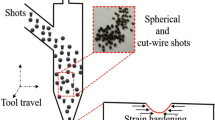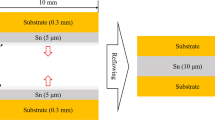Abstract
To improve the reliability of electronic devices, electromigration (EM) in lead-free solders is actively being studied. In particular, EM testing methods that use 1-D stripe samples have significant merit. However, some aspects of the reasonability of the EM resistance evaluation remain to be discussed. In this study, the validity of the evaluation method utilising stripe-shaped samples without passivation was verified. Sn-3.0Ag-0.5Cu (SAC) and Sn-3.5Ag-0.5Cu-0.07Ni-0.01Ge (SACNG) solders (in wt.%) with a reference of four nine Sn were used as testing materials for the verification. EM resistance was evaluated by measuring the total volume of hillocks observed in the designated region per unit time of current supply. First, the effect of sample length on EM was confirmed by observing the hillock volume, which increased based on the sample length. In addition, EM resistance was ranked Sn < SAC < SACNG under a combination of experimental conditions as well as under another combination of the conditions. Therefore, the consistency of the EM resistance ranking regardless of the experimental conditions was shown through the experiment. Furthermore, an evaluation formula including the effects of sample length on the EM was derived. Finally, it was theoretically shown that the present method of EM resistance evaluation was consistent regardless of the experimental conditions. These experimental results and theoretical discussion demonstrated the validity of the presented evaluation method.





Similar content being viewed by others
References
Abé H, Sasagawa K, Saka M (2006) Electromigration failure of metal lines. Int J Fract 138:219–240. doi:10.1007/s10704-006-0059-6
Blech IA (1976) Electromigration in thin aluminum films on titanium nitride. J Appl Phys 47:1203–1208. doi:10.1063/1.322842
Carslaw HS, Jaeger JC (1959) Conduction of heat in solids, 2nd edn. Clarendon, Oxford, pp 133–161
Chen CM, Huang CM (2008) Effects of silver doping on electromigration of eutectic SnBi solder. J Alloy Compd 461:235–241. doi:10.1016/j.jallcom.2007.07.059
Hasegawa M, Sasagawa K, Saka M (2005) Derivation of film characteristic constants by using governing parameter for electromigration damage in passivated bamboo line. In: Proceedings of 11th international conference on fracture, Paper ID 3699
Ho PS, Kwok T (1989) Electromigration in metals. Rep Prog Phys 52:301–348. doi:10.1088/0034-4885/52/3/002
Huang FH, Huntington HB (1974) Diffusion of 124Sb, 109Cd, 113Sn, and 65Zn in tin. Phys Rev B 9:1479–1488. doi:10.1103/PhysRevB.9.1479
Huntington HB, Grone AR (1961) Current-induced marker motion in gold wires. J Phys Chem Solids 20:76–87. doi:10.1016/0022-3697(61)90138-X
Lin CF, Lee SH, Chen CM (2012) Effect of Sn grain orientation on the Cu6Sn5 formation in a Sn-based solder under current stressing. Metall Mater Trans A 43:2571–2573. doi:10.1007/s11661-012-1276-4
Lu M, Shih DY, Goldsmith C, Wassick T (2009) Comparison of electromigration behaviors of SnAg and SnCu solders. IEEE Int Reliab Phys Symp Proc, pp 149–154. doi:10.1109/IRPS.2009.5173241
Meakin JD, Klokholm E (1960) Self-diffusion in tin single crystals. Trans Met Soc AIME 218:463–466
National Astronomical Observatory of Japan (2012) Chronological science tables 2013. Maruzen, Tokyo (in Japanese)
Saka M, Kohara T, Hasegawa T, Yamashita M (2009) A simple method for testing the electromigration resistance of solders. Microsyst Technol 15:17–25. doi:10.1007/s00542-008-0642-z
Sasagawa K, Saka M (2011) Basis of atomic diffusion. In: Saka M (ed) Metallic micro and nano materials—Fabrication with atomic diffusion. Springer, Heidelberg, pp 15–51
Wang PC, Filippi RG (2001) Electromigration threshold in copper interconnects. Appl Phys Lett 78:3598–3600. doi:10.1063/1.1371251
Watanabe H, Hidaka N, Shohji I, Ito M (2006) Effect of Ni and Ag on interfacial reaction and microstructure of Sn-Ag-Cu-Ni-Ge lead-free solder. Proc MS&T 2006:135–146
Wei CC, Liu CY (2005) Electromigration studies of Sn (Cu) and Sn (Ni) alloy stripes. J Mater Res 20:2072–2079. doi:10.1557/JMR.2005.0257
Zhao X, Saka M, Yamashita M, Hokazono H (2012) The effect of adding Ni and Ge microelements on the electromigration resistance of low-Ag based SnAgCu solder. Microsyst Technol 18:2077–2084. doi:10.1007/s00542-012-1577-y
Acknowledgments
This study was subsidised by JKA through its promotion funds from AUTORACE and supported by JSPS Grant-in-Aid for Scientific Research (B) 23360050. The authors would like to acknowledge Associate Prof. Tohmyoh, H. and Assistant Prof. Li, Y. at Tohoku University for their valuable discussion throughout this work.
Author information
Authors and Affiliations
Corresponding author
Rights and permissions
About this article
Cite this article
Aoyama, M., Saka, M. Evaluation of electromigration resistance of lead-free solders using unpassivated stripe-shaped samples. Microsyst Technol 21, 1777–1785 (2015). https://doi.org/10.1007/s00542-014-2284-7
Received:
Accepted:
Published:
Issue Date:
DOI: https://doi.org/10.1007/s00542-014-2284-7




